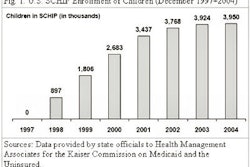LAS VEGAS - The proposed reductions for diagnostic imaging reimbursement outlined in the Deficit Reduction Act (DRA) of 2005 will impact much more than the providers of outpatient-based diagnostic imaging services in the U.S. Medicare beneficiaries, investors, financiers, and medical research and development will all bear the burden of the draconian cuts, according to Cherrill Farnsworth, executive director of the lobbying organization National Coalition for Quality Diagnostic Imaging Services (NCQDIS) in Washington, DC.
"When the diagnostic imaging industry contracts, and private equity stays away, and the banks are scared (to lend money), new technologies slow down," Farnsworth said. "You're just not going to see smart venture capital running to this market right now until this (the DRA 2005 cuts) is resolved."
Farnsworth shared her thoughts on the wider implications of the DRA 2005 during a special presentation at the American Healthcare Radiology Administrators (AHRA) annual meeting this week.
"The investors that are already in the market are trying to figure out what they're going to do," she said. "You can't just put more money in. Although we're a volume business, you can't increase the volume of ultrasound scans with a 75% cut and expect to make it up that way. There just aren't enough hours in the day."
MPFS versus HOPPS
The DRA 2005 (Section 5102) mandates that reimbursement for Medicare beneficiaries who utilize outpatient imaging services at centers not affiliated with a hospital be linked to the Hospital Outpatient Prospective Payment System (HOPPS) effective January 1, 2007. Before the legislation was passed, these charges were paid according to the Medicare Physician Fee Schedule (MPFS).
"MPFS is designed to accurately reflect the costs of imaging services provided in physician offices and freestanding facilities," Farnsworth said. "The system has been validated with several updates over the years."
The MPFS reimbursement formula takes into account factors that are specific for freestanding diagnostic imaging facilities such as separate payment codes and rates, capital infrastructure, overhead costs, and staffing and equipment maintenance.
The HOPPS formula was created with the fundamental assumption that costs are shared across a facility and its subspecialties. The system bundles procedures, does not address all expenses, and provides for additional reductions to allow for outlier and pass-through payments for new diagnostic imaging technologies, Farnsworth said.
"The DRA legislation ignores the fundamental distinctions between the MPFS and HOPPS payment systems in accurately calculating payments for services provided in freestanding facilities versus hospital settings," she said.
Depending on the service provided in an independent diagnostic imaging facility, providers are looking at reimbursement reductions of up to 75%, according to Farnsworth. Broken down by modality, some MRI services will see a 50% cut, some CT services will have a 40% reduction in compensation, and ultrasound reimbursement will be slashed by as much as 75%.
"For example, in 2006, a standard CT chest/abdomen/pelvis with contrast will drop in reimbursement from 2005's rate of $829.96 without discount to $693.15," Farnsworth said. "Presuming no change in the 2007 conversion factor and enactment of the DRA, this multiple examination will decrease to $510.86 next year, a decrease of about 38% from 2005 technical reimbursement."
Even more troubling for providers who have invested in PET/CT technology, PET payments are scheduled to take a crippling 30% to 50% downturn -- despite the fact that Medicare only recently established a payment code for PET/CT scans in April of last year.
"This is an unprecedented cut for a new technology that has been shown to be effective in changing the course of treatment for cancer patients," Farnsworth noted.
Less is less, not more
The net result of enacting the DRA 2005 as currently written will be that certain imaging providers will be forced out of business, while others will scale back services that are poorly reimbursed or limit their availability to specific populations. Essentially, Medicare, Medicaid, and indigent patients will have difficulty in gaining access to imaging technologies.
Also, because revenues will sharply decrease, investment in new imaging technology will be severely curtailed by freestanding centers, resulting in the provision of imaging services with older and, as time goes on, outdated equipment, which may impact the quality of care, Farnsworth said.
Medicare beneficiaries who are now trying to swallow the costs of the "doughnut hole" provisions of the prescription drug act will also get to bear the increased co-payment tied to the conditions of hospital-based imaging services.
"Beneficiaries on fixed incomes who pay a 20% co-payment for imaging services outside of the hospital will have to pay up to 40% if forced to go to a hospital outpatient department for care," Farnsworth said. "For example, the beneficiary co-payment of a CT scan of the head/brain would double from $38 in a physician office or freestanding facility to $75 in the hospital outpatient department."
Waiting times for diagnostic imaging services are certain to increase as a result of DRA 2005 provisions. The average wait time currently for nonurgent imaging care in a hospital outpatient setting is approximately 10-14 days. The result of freestanding imaging centers shuttering their doors or curtailing services will dramatically increase the volume of patients seeking care at these facilities, many of which are currently operating at 95% of capacity.
"For example, patients with a history of stroke could end up waiting up to six weeks for a vascular ultrasound study because hospitals currently report only 4.5% excess capacity," Farnsworth observed.
As the imaging centers that are left contract, consolidate, and limit access, Medicare beneficiaries may be forced to travel greater distances to obtain imaging services, and additional expenses such as transportation are not covered under Medicare. As a result, these patients may opt out of obtaining diagnostic imaging, putting off their healthcare services until they require costly invasive procedures and in-patient care.
The reimbursement reductions could well have an effect in the private sector payment arena as well, Farnsworth said. Some private payors have indicated that they will be following Medicare's lead, tying their health plan contracts to Medicare reimbursement. Again, because Medicare rates may become the ceiling rather than the floor for service payments, providers will be forced to make business decisions that curtail services for some populations, she said.
Technology in statis
"The imaging industry brings cutting-edge technologies to the market in ways that are changing the face of healthcare, but may not have the means to do so if payment rates are cut by Medicare and private payors," Farnsworth said.
If few entities are able to buy new diagnostic imaging technology, or the market contracts to the point where it is no longer cost-effective to invest in new imaging technology, industry will scale down research and development in this area. The scientists and engineers currently involved in these projects will seek employment in other fields, and the pace of innovation will slow as a result.
"Patients will not benefit from technology that assists with earlier diagnosis and more targeted treatment of disease, such as advanced MR neuron imaging for brain tumor treatment planning," Farnsworth said.
Throwing the baby out with the bathwater
Opposition to the DRA 2005 is not an endorsement of the increased utilization of imaging services that has been driven by in-office self-referral exemptions to the Stark laws, she said. The NCQDIS holds that to address the rapid growth in imaging utilization, private payors and purchasers have to set minimum quality standards for imaging facilities and equipment, or hire third-party utilization review companies (radiology benefits management companies) to review physician-ordered imaging procedures for appropriateness.
In addition, the organization believes that all imaging providers should be subject to the same quality guidelines already established by the Centers for Medicare and Medicaid Services (CMS), with uniform adoption of those requirements to ensure a minimum level of quality standards for Medicare beneficiaries. NCQDIS also supports private and government efforts to restrict leasing of imaging time on equipment not located in the physician office.
"Without consistent quality standards, cutting reimbursement seems the natural alternative to ensure appropriate utilization," Farnsworth said. "However, cutting reimbursement alone will not yield the desired effect. Cost-cutting alone may encourage some providers who are able to control volume to increase referrals to make up the difference in lost revenue. Worse, it may also increase costs as tests are done more often on poorer equipment, causing misdiagnosis."
The organization is encouraged that some states, such as Maryland, have enacted legislation that does not permit nonradiologist physicians to refer to imaging equipment or facilities in which they have a financial interest. Also, other states have passed laws making it illegal for physicians to lease time on imaging equipment that is not located in their facility, then bill for those procedures.
"Parity in reimbursement with consistent quality standards are needed, but this parity must be determined carefully," Farnsworth said.
By Jonathan S. Batchelor
AuntMinnie.com staff writer
August 2, 2006
Related Reading
Groups testify against DRA imaging cuts, July 19, 2006
Public Citizen makes case against DRA, July 11, 2006
House bill seeks to delay DRA imaging cuts, June 29, 2006
House bill proposes repeal of DRA imaging cuts, May 3, 2006
DRA 2005 in practice: Where the rubber meets the road, April 27, 2006
Copyright © 2006 AuntMinnie.com



















